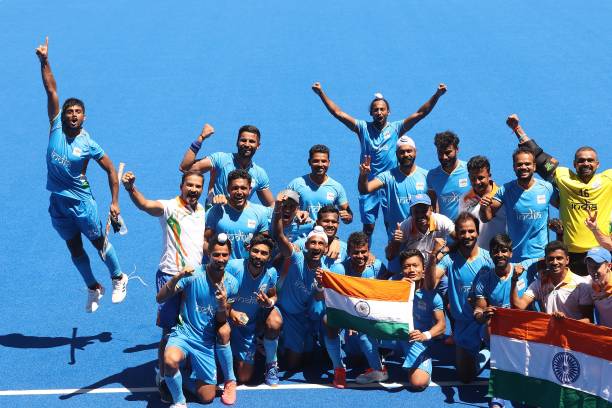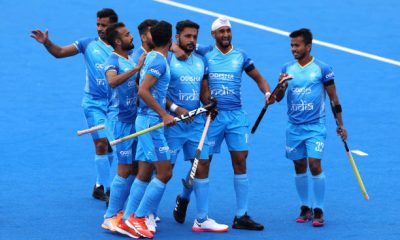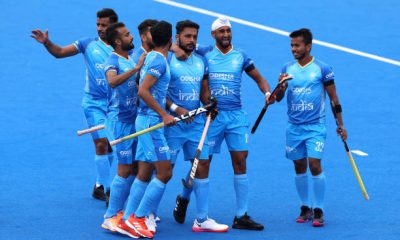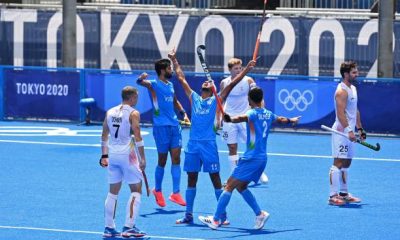
Introduction
Hockey has been an integral part of India’s sporting history, symbolizing national pride and excellence. From Indian Hockey dominance in the early 20th century to a period of decline and eventual resurgence, it has witnessed a fascinating evolution. This article delves deep into the journey of Indian Men in Blue, exploring its golden era, challenges, revival efforts, and future prospects.
The Golden Era of Indian Hockey (1928-1956)
The early years of Men in Blue were marked by an era of unparalleled dominance. The national team won six consecutive Olympic gold medals, establishing India as the world’s leading hockey powerhouse.
Key Highlights:
- 1928 Amsterdam Olympics: India won its first Olympic gold, defeating the Netherlands 3-0.

- 1932 Los Angeles Olympics: The team dominated with a 24-1 win over the USA in the final.
- 1936 Berlin Olympics: Led by the legendary Dhyan Chand, India defeated Germany 8-1, in what is regarded as one of the greatest hockey performances ever.
- 1948 London Olympics: India’s first Olympic gold as an independent nation, defeating Great Britain 4-0.
- 1952 & 1956 Olympics: Further victories reinforced India’s global supremacy in hockey.
What Made India Dominant?
- Dribbling Excellence: Indian players mastered the art of dribbling, making it difficult for opponents to take possession.
- Superior Skillset: Players like Dhyan Chand revolutionized the game with their stickwork and finishing ability.
- Strategic Play: India’s attack-heavy strategy overwhelmed opponents who lacked counter-strategies.
The Decline of Indian Hockey (1960-2008)
Despite its early success, Indian Men in Blue faced a decline from the 1960s onwards due to various factors.
Major Challenges:
- Shift from Grass to AstroTurf: The introduction of AstroTurf in the 1970s favored European teams who adapted quickly.
- Lack of Structural Development: Poor infrastructure and inadequate training facilities hampered India’s ability to compete at the highest level.
- Rise of European & Australian Teams: Teams like the Netherlands, Germany, and Australia dominated with faster, structured play.
- Declining Grassroots Development: The lack of a strong talent pipeline led to inconsistency in team performance.
- 2008 Beijing Olympics: India failed to qualify for the Olympics for the first time in history, marking a low point in Indian hockey.

The Revival of Indian Hockey (2010-Present)
The last decade has seen a remarkable resurgence of Indian hockey, with concerted efforts from the Hockey India Federation, government initiatives, and improved coaching standards.
Key Milestones in the Revival:
- 2014 Asian Games: India won gold, marking a turnaround in performance.
- 2016 Champions Trophy: India finished as runners-up, displaying renewed competitiveness.
- 2018 Asian Champions Trophy: India shared the title with Pakistan, underlining its dominance in Asia.
- 2021 Tokyo Olympics: India clinched a historic bronze medal, its first Olympic hockey medal in 41 years.
- 2023 Asian Games: India secured another gold, reaffirming its regional supremacy.
Factors Behind the Revival:
- Government & Private Sponsorships: Increased funding for training, infrastructure, and international exposure.
- Foreign Coaches & Modern Techniques: Coaches like Terry Walsh and Graham Reid have introduced tactical flexibility.
- Improved Fitness & Training Methods: Greater emphasis on strength, endurance, and speed to match global standards.
- Development of Leagues: The Hockey India League (HIL) provided young talents an opportunity to play alongside international stars.
- Grassroots Programs: Initiatives to scout and develop young players at a grassroots level.

Future Prospects: The Road Ahead for Indian Hockey
With a strong foundation laid for resurgence, Indian hockey has the potential to reclaim its position among the world’s elite.
SUGGESTED FOR YOU
The Profound Impact of Bollywood on Indian Sports: 5 Key Influences
The Glorious History of Cricket in India: From the 1800s to Now
Key Focus Areas for Continued Growth:
- Sustaining Consistency: Regular podium finishes in international tournaments will cement India’s place in the top tier.
- Expanding Domestic Leagues: A robust national league can nurture upcoming talent and increase the sport’s popularity.
- Enhanced Infrastructure: More world-class training facilities and academies need to be developed.
- Women’s Hockey Growth: The Indian women’s team has shown promise and needs further support to compete at the highest level.
- Technology & Data Analysis: Incorporating analytics into game strategy can refine player performance.
- Attracting More Youth: Schools and colleges must integrate hockey more actively into their sports curriculum.
Conclusion
The evolution of Indian hockey is a tale of glory, challenges, and resurgence. From ruling the world stage to facing setbacks and now staging a strong comeback, India’s Men in Blue journey is inspiring. The bronze medal at the 2021 Tokyo Olympics rekindled hope, signaling that Indian hockey is on the right path toward regaining its lost glory.
With structured development, continued investment, and unwavering passion, Indian hockey is poised to rise to new heights in the years to come. The journey is far from over, and the best may yet be ahead for Indian hockey.
Frequently Asked Questions (FAQs)
Q1: When was the golden era of the Men in Blue? A: The golden era was between 1928 and 1956, during which India won six consecutive Olympic gold medals.
Q2: Why did Indian hockey decline? A: Factors such as the shift to AstroTurf, lack of infrastructure, and rising competition from European and Australian teams led to the decline.
Q3: How has Indian hockey revived in recent years? A: Better coaching, structured leagues, increased funding, and improved fitness programs have contributed to the resurgence of Indian hockey.
Q4: What was India’s biggest achievement in recent hockey history? A: The bronze medal at the 2021 Tokyo Olympics was a historic moment, marking India’s return to the Olympic podium after 41 years.
Q5: What is the future of Indian hockey? A: Continued investments, grassroots programs, and modern strategies will help Indian hockey regain its place among the world’s top teams.
With India’s renewed focus on hockey development, the sport is once again capturing the nation’s imagination. As the team prepares for future global tournaments, there is optimism that Indian Men in Blue will shine brighter than ever before.









